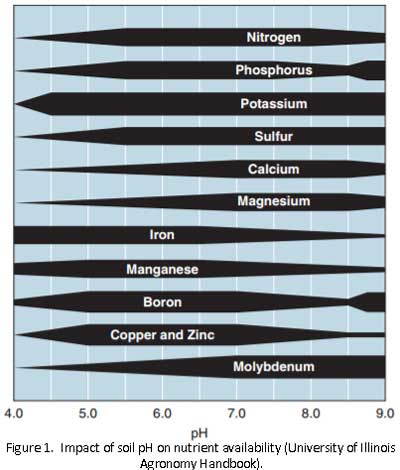- Early season nutrient deficiencies are often temporary and corrected by favorable weather.
- Deficiency symptoms that persist further into the season require additional investigation.
- Deficiencies may be due to either insufficient soil test levels or other factors that restrict nutrient availability and plant uptake.
- Soil pH is the single most important management factor affecting nutrient availability.
- Soil and tissue tests can provide critical diagnostic information on nutrient deficiencies.
- Proper sample collection and handling is imperative for meaningful results with tissue tests.
When corn reaches growth stage V3 to V5, the plant transitions from depending on the seed for energy to relying on photosynthesis. Also at this the stage, the plant transitions to using the main nodal root system to acquire nutrients from the soil. Cool, wet soils during this transition period can lead to temporary nutrient deficiencies, resulting in uneven growth and visual deficiency symptoms. While these cosmetic issues can be unsettling for the farmer, the operative word here is 'temporary', because favorable weather may correct the problem. Warmer temperatures and drier soils stimulate microbial activity and encourage root growth. More nutrients are being made available from organic matter, the expanding root system is more likely to intercept those nutrients, and the corn recovers.

However, visual nutrient deficiency symptoms that persist further into the growing season will require some additional investigative work. Deficiencies may occur either when nutrient concentrations are below a critical level in the soil, or when other factors limit nutrient availability or plant uptake, such as soil pH, compaction, drought, nematode or insect injury, disease, and herbicide injury.
Soil tests are an excellent tool to reveal information about nutrient levels in the soil, especially when collected at the same time as a foliar tissue test. Bear in mind that soil tests cannot be relied upon solely to predict nutrient deficiencies and soil test reliability varies by nutrient. For example, the reliability of phosphorus and potassium soil tests is relatively high, but the reliability of soil tests for sulfur, magnesium, zinc, and manganese is lower. Soil test levels must be used in combination with other pieces of information to paint the complete picture of nutrient availability to the plant.
Water pH is the most completely reliable soil test value and is the most important factor impacting nutrient availability. Nutrient availability across the full suite of essential nutrients is best optimized at a soil pH of around 6.5. When soil pH falls below 5.0, availability can become limiting for nitrogen, phosphorus, magnesium, boron, and molybdenum (see Figure 1). Managing soil pH through a prescribed variable rate lime program based on routine grid soil testing is the most important step you can take in your farm operation to correct nutrient deficiencies.
Foliar tissue tests can be a solid complement to the soil test. Tissue tests can help diagnose a nutrient deficiency problem in-season or validate the success of a nutrient management plan. Early season tissue testing can facilitate corrective actions to be taken during the season, such as a foliar nutrient application. Tissue tests at silking stage can be used to retroactively diagnose a problem to be corrected in future management plans.
Be aware that tissue tests are highly calibrated to specific plant parts at specific growth stages. Sample collection and handling are critical to ensure reliable tissue test outcomes. Some key points to remember:
- Sample at least 20 plants per field area to overcome natural variability from plant to plant.
- Good versus bad comparisons can also be useful to check for differences.
- For corn less than 12" tall, clip one inch above the soil surface and submit whole plant specimens.
- For corn between 12" and silking stage, sample the first mature leaf below the whorl.
- For corn at R1 (silking) growth stage, submit the entire ear leaf.
- Dust residues should be rinsed from the tissue samples using only distilled water.
- Submit samples to the lab immediately in brown paper bags, never sealed plastic.
Your FS Crop Specialist is a vital agronomic resource to ensure proper soil and tissue testing procedures, to interpret test results and diagnose problems, and to work with you to craft an effective nutrient management strategy for your farm.